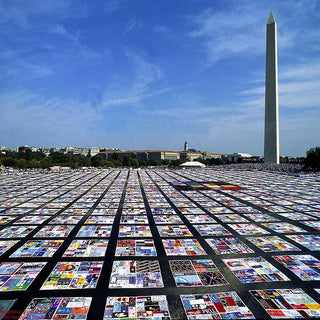
In the throes of the 1980s AIDS crisis, a powerful and enduring symbol of compassion and unity emerged - the AIDS Memorial Quilt. A poignant amalgamation of art, activism, and remembrance, the quilt stands as a testament to lives lost and a community's unbreakable spirit. In this exploration, we journey through its historical origins, delve into significant milestones, and unravel the lesser-known narratives woven intricately into the fabric of the AIDS Memorial Quilt.

The AIDS Memorial Quilt found its genesis during a time of unparalleled suffering. The 1980s marked the height of the AIDS epidemic, a period when the world grappled with the mysterious and deadly disease. Amidst the confusion and fear, Cleve Jones, an LGBTQ+ rights activist, ignited the idea of the quilt. Inspired by a candlelight vigil in San Francisco in 1985, where attendees held placards bearing the names of those lost to AIDS, Jones envisioned a patchwork quilt as a collective memorial. This concept of interconnectedness amid loss laid the foundation for an unprecedented commemorative endeavor.

"Every panel is supposed to be 3-foot-by-6-foot, the size of a grave, because we were laying out the dead down at the White House for the 1987 National March on Washington for Lesbian and Gay rights - we were showing how much space it would take up if it was a graveyard" says Gert McMullin, who has helped sew and repair the Memorial Quilt since its inception in 1987. These panels encompass the essence of those lost – their hobbies, passions, and connections. As panels are added, the quilt evolves into a vibrant mosaic of individual stories, a deeply personal and shared narrative of resilience.

From its modest beginnings, the AIDS Memorial Quilt quickly grew to reflect the enormity of the crisis. By the late 1980s, the quilt consisted of thousands of panels, each one a poignant reminder of a life extinguished too soon. The quilt's size posed logistical challenges, culminating in the creation of display guidelines. Names, photographs, and personal effects graced the panels, serving as visual tributes to those who were often ignored by society. As it expanded, the quilt underscored the magnitude of the epidemic, demanding recognition and action.
Beyond its role as a solemn memorial, the AIDS Memorial Quilt galvanized communities in the fight against AIDS. Assembling panels became a communal act of healing, as friends, partners, and allies joined forces to remember and grieve. The quilt provided a space for voices silenced by discrimination and stigma, enabling a powerful form of activism. It nurtured a sense of belonging, encouraging marginalized individuals to share their stories, advocate for change, and fight for equality and access to healthcare.

Despite medical advancements and heightened awareness, the AIDS Memorial Quilt remains profoundly relevant. The stories it carries remind us that the fight against AIDS extends beyond medical breakthroughs. Discrimination, lack of education, and access to treatment persist. The quilt's presence acts as a call to action, urging societies to address these enduring issues. Its legacy endures as a testament to collective strength and a reminder that unity can dismantle barriers.
Make a quilt for a lost loved one, read individual stories, or donate through:




